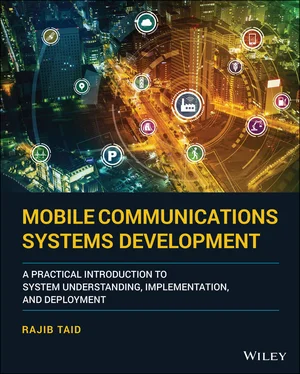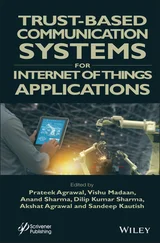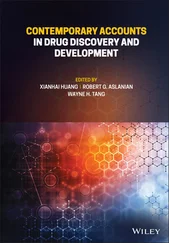Network Identities for LTE/EPS Network elements
Various identities are used to identify network elements or logical objects, at the protocol layer level, of an LTE/EPS network. Such network identities, as elucidated in Example 5.1below, may be assigned as part of a periodical network planning or maintenance processes or can be generated and assigned by a network element dynamically to another network element as part of a protocol layer procedure.
Example 5.1Network Identities of LTE Network Elements
Figure 5.2illustrates the fundamental identity assigned to some of the network elements of an LTE/EPS PLMN.

Figure 5.2 Illustration: identities for LTE network elements.
Several network identities also contain the PLMN Id. The purposes of the network identities shown in Figure 5.2are described below:
E‐UTRAN Cell Identity (ECI) (28 bits in length): It is a unique cell identity and cannot be repeated in a PLMN. It is defined as the SIBType1. CellIdentity; refer to TS 36.331 [94]. An ECI together with the PLMN Id constitutes an E‐UTRAN Cell Global Identity (ECGI).
eNB Id (28 bits length): It identifies an eNodeB within a PLMN.
Radio Network Temporary Identifier (RNTI) (16 bits length): It identifies a UE having a Radio Resource Control (RRC) connection and also can be scheduled for data transmission/reception.
MMEC (8 bits length): MME Code – identifies MME with the MME group.
MMEGI (16 bits length): MME Group Id – identifies the MME Group Id of that an MME belongs to.
Globally Unique Temporary Identity (GUTI)
In the case of the LTE/EPS system, a mobile device UE is uniquely identified by a GUTI that is allocated by the MME. A GUTI is similar to a P‐TMSI and is used as the identity of a UE during the LTE/EPS mobility management‐related procedures executed between a UE and the MME. A GUTI can be a native or mapped as described later in Section 5.5. A GUTI is constructed from several fundamental network identities as illustrated in Example 5.2.
Example 5.2LTE/EPS Globally Unique Temporary UE Identity (GUTI)
A GUTI is an LTE/EPS network‐level identity that has end‐to‐end significance and is used to provide unambiguous identification of a UE. The construction, as well as its hierarchical structure of a GUTI, is shown in Figure 5.3.
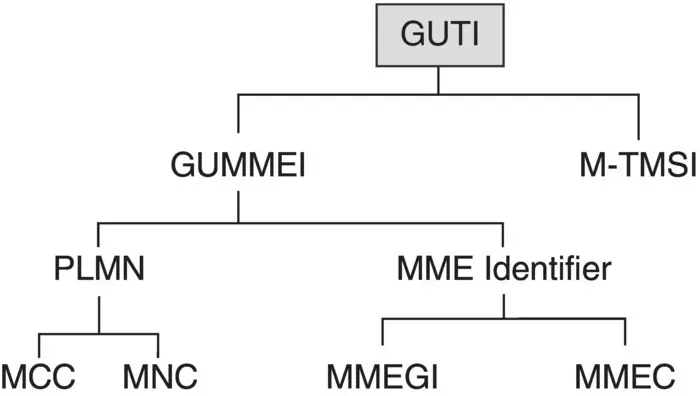
Figure 5.3 Illustration: components and derivation of a GUTI.
Using a GUTI, the identification of the MME and its corresponding network can be determined. It can be used by the network and the UE to establish the UE's identity during signaling between them in the LTE/EPS network.
Physical Layer Identity of a Cell
At the physical layer level, each cell in an LTE/E‐UTRAN network is identified through a Physical Cell Identity (PCI), which is illustrated through Example 5.3and Figure 5.4.
As defined by the TS 36.211 [90], there are 504 unique Physical Layer Cell Identities, and they are divided into 168 (0–167) unique Physical Layer Cell Identity groups; each group has three (0, 1, 2) unique identities. A PCI has the relationships and is derived from the downlink reference signals primary synchronization signal ( PSS ) and secondary synchronization signal (SSS) which are transmitted from a base station. The mathematical relationship among the PCI, PSS and SSS is shown below.
PCI= (3* Physical Cell Identity Group) + Physical Layer Identity Where Physical Cell Identity Group =0 to 167; Physical Layer Identity=0 to 2.
The PSS has the link to the Physical Layer Identity, which is a Zadoff–Chu sequence, and the SSS has the link to the PCI group. A UE reads the synchronization signals during a cell search procedure in the LTE system. To avoid interference and PCI collision as well as confusion issues, the same PCI is never reused in the neighbouring cells. A PCI collision occurs when two adjacent cells have the same PCI. A PCI confusion occurs when a cell has two neighbours with the same PCI. As the number of PCIs (504) is limited, PCIs are carefully planned and repeated in other cells that are not adjacent or neighbor to each other as shown in Figure 5.4.
Example 5.3LTE Physical Layer Cell Identity (PCI)
A cell in the LTE system can have three types of identities:
An ECI of 28 bits in length as mentioned in Example 5.1, which identifies a cell in a particular LTE network. It is defined and controlled by the higher layer. It is also used from the operation and maintenance point of view.
An E‐UTRAN Cell Global Identifier (ECGI), containing the PLMN Id, that identifies a cell globally, i.e. anywhere in the world,
A Physical Cell Identity (PCI) is used at the LTE Physical Layer level only ( Figure 5.4), and it is defined as the PhysCellId in the TS 36.331 [94].
Figure 5.4illustrates the LTE Physical Layer Cell Identities (PCI) and their groups. The PCI is similar to the UMTS scrambling code concept, for which a RAN planning is required for its proper usages. A PCI helps a UE to distinguish information received from different neighboring transmitters and select a particular cell to camp‐on at the physical layer level.
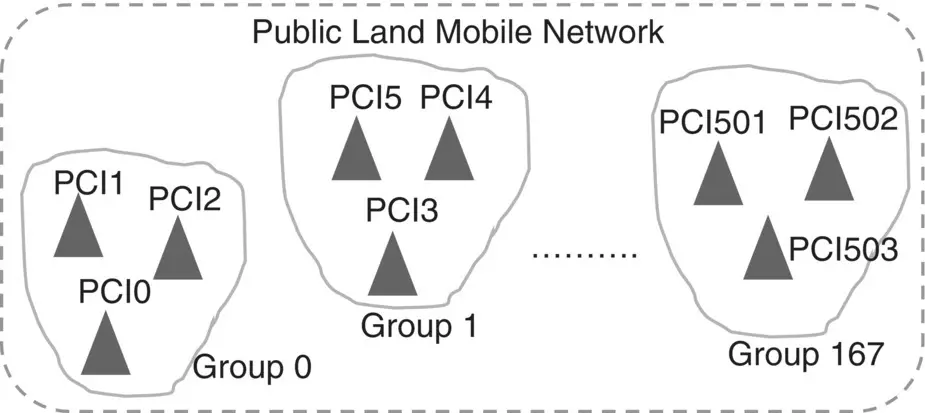
Figure 5.4 Illustration: LTE physical layer cell identities (PCI) and groups.
5.4 Temporary Identities Assigned by RAN: RNTI
RNTI stands for Radio Network Temporary Identifier that is allocated by the UMTS UTRAN, LTE E‐UTRAN, and 5G NG‐RAN to UEs. An RNTI uniquely identifies a UE and is used during the communication between UTRAN or E‐UTRAN or NG‐RAN and a UE over their air interface: Uu. The RNTIs used in the LTE system is described below:
LTE E‐UTRAN: Allocation of RNTIs, TS 36.300 [92]
LTE E‐UTRAN also allocates several RNTI types to address a particular UE over its air interface. However, unlike the UMTS system, it is also possible to address multiple UEs in the LTE system. This is because the LTE E‐UTRAN uses the physical downlink shared channel (PDSCH) to transmit control as well as user data to a UE. Thus, a mechanism is required by an LTE UE to differentiate the type of information received from the E‐UTRAN. To achieve this, different types of RNTIs are used by E‐UTRAN as described below. For more information on LTE RNTI values and usages, refer to TS 36.321 [93]:
System Information (SI)‐RNTI – It is used to broadcast system information from the E‐UTRAN to the UEs/cell through the Broadcast Control Channel (BCCH). SI‐RNTI is part of the cyclic redundancy check (CRC) added to the contents of the downlink control information (DCI) format 1A.
Paging (P)‐RNTI – It is used by the UEs for the reception of paging from the E‐UTRAN through the Paging Control Channel (PCCH).
Cell(C)‐RNTI – C‐RNTI uniquely identifies a UE having RRC signaling connection, and scheduling, with E‐UTRAN in a particular cell. C‐RNTI is used by the E‐UTRAN to provide an uplink transmission grant and downlink assignment.
Temporary C‐RNTI – It is generated by the MAC layer of an eNodeB and sends it in the Random Access Response (RAR) to the UE as a response to the Random Access Preamble transmitted by the UE. Temporary C‐RNTI is later changed to the C‐RNTI once the UE contention is resolved at the eNodeB end.
Читать дальше
